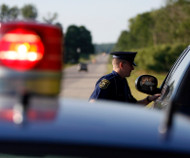7/12/2017
Research Paper Quantifies Bias In Traffic Stops And SearchesStanford University study shows black drivers more likely to be searched in traffic stops.

Motorists are statistically more likely to be searched during a traffic stop if they are black or Hispanic. That was the finding of a working paper released last month by researchers with Stanford University's Open Policing Project.
The project has been collecting records on the 50,000 traffic stops conducted each day and publishing the results in a database covering over 136 million stops nationwide, with some states offering more complete information than others. The study focused on a smaller sample, 64 million records, of state patrol stops in twenty states covering the years 2011 to 2015. The researchers' goal was to find whether there was statistically significant evidence of racial bias.
By the numbers, blacks are stopped more often than whites, but Hispanics have the advantage of being stopped less often than whites.
"Such disparities may stem from a combination of factors -- including differences in driving behavior -- and are not necessarily the result of racial bias," the paper explains.
When white drivers aged 20 to 29 are pulled over, 72 percent are given speeding tickets compared to 75 percent for black drivers and 77 percent for Hispanic motorists. In 2 percent of stops, whites are searched compared to 3.5 percent for black drivers and 3.8 percent for Hispanics.
"After controlling for stop location, date and time, and driver age and gender -- via logistic regression, as above -- we find that black and Hispanic drivers have approximately twice the odds of being searched relative to white drivers," the paper explained.
The researchers argued that the higher search rate would be legitimate if minority drivers are actually carrying contraband more often. So they looked at the data to determine the "hit rate" or how often searched motorists were found to be carrying drugs. The hit rates for blacks and whites were roughly the same at 28 percent, but the Hispanic hit rate was lower at 22 percent. The working paper then performed a statistical threshold test that suggested there is evidence of discrimination against both black and Hispanic drivers, but the researchers said the results were not definitive.
"The threshold test provides evidence of bias in search decisions," the paper concluded. "However, as with all tests of discrimination, there is a limit to what one can conclude from such statistical analysis alone. For example, if search policies differ not only across but also within jurisdictions, then the threshold test might mistakenly indicate discrimination where there is none."
The paper also found evidence that the decriminalization of marijuana possession in Colorado and Washington reduced the number of searches during traffic stops plummeted.
A copy of the report is available in a 1.3mb PDF file at the source link below.


